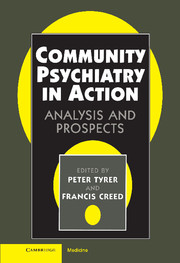Book contents
- Frontmatter
- Contents
- List of contributors
- 1 Essential issues in community psychiatry
- 2 Evaluation of community treatments for acute psychiatric illness
- 3 Synopsis of the Daily Living Programme for the seriously mentally ill: a controlled comparison of home and hospital based care
- 4 Evaluation of a complete community service
- 5 Early intervention study of psychiatric emergencies
- 6 Evaluation of psychiatric services: the merits of regular review
- 7 A home based assessment study
- 8 Home treatment as an alternative to acute psychiatric inpatient admission: a discussion
- 9 The toxicity of community care
- 10 Community mental health services: towards an understanding of cost-effectiveness
- 11 Future research strategies
- Index
3 - Synopsis of the Daily Living Programme for the seriously mentally ill: a controlled comparison of home and hospital based care
Published online by Cambridge University Press: 06 July 2010
- Frontmatter
- Contents
- List of contributors
- 1 Essential issues in community psychiatry
- 2 Evaluation of community treatments for acute psychiatric illness
- 3 Synopsis of the Daily Living Programme for the seriously mentally ill: a controlled comparison of home and hospital based care
- 4 Evaluation of a complete community service
- 5 Early intervention study of psychiatric emergencies
- 6 Evaluation of psychiatric services: the merits of regular review
- 7 A home based assessment study
- 8 Home treatment as an alternative to acute psychiatric inpatient admission: a discussion
- 9 The toxicity of community care
- 10 Community mental health services: towards an understanding of cost-effectiveness
- 11 Future research strategies
- Index
Summary
Introduction
Two sources of ambiguity
The subject of this book is the functioning of community care and is mainly concerned with acute psychiatric illness. Ambiguities in this frame of reference require examination to understand the Daily Living Programme (DLP) study discussed below. Such ambiguities reflect universal difficulties in the classification of psychiatric illnesses and their treatments.
The first type of ambiguity concerns the term ‘acute’. Does ‘acute’ mean sudden onset, recent onset, marked severity or all three? Does it include sudden recent onset of severe obsessive-compulsive disorder which can cripple the patient and family as much and for as long as do psychotic disorders? Are we only considering schizophrenia and affective psychosis? Does ‘acute’ mean a first-ever crisis? Can it mean a new crisis in a chronic illness? Does it include the same patients when they are no longer in crisis? Similar ambiguities also appear if we use the term ‘severe mental illness’ (SMI) instead of ‘acute’ mental illness.
Meaningful comparisons across treatment studies require reasonable similarities across their patient samples. Creed's valuable contrast (Chapter 1) showed that in none of the DLP and four other studies presented in this volume did every patient have a diagnosis of schizophrenia or affective psychosis. Following entry to the study only 12% of the DLP patients turned out to have a non-psychotic diagnosis on the Present State Examination (PSE), in contrast to the far higher proportion in the other studies described in this volume. The DLP had a higher proportion of patients with schizophrenia (49%) than did any of the other studies.
- Type
- Chapter
- Information
- Community Psychiatry in ActionAnalysis and Prospects, pp. 29 - 44Publisher: Cambridge University PressPrint publication year: 1995
- 4
- Cited by



